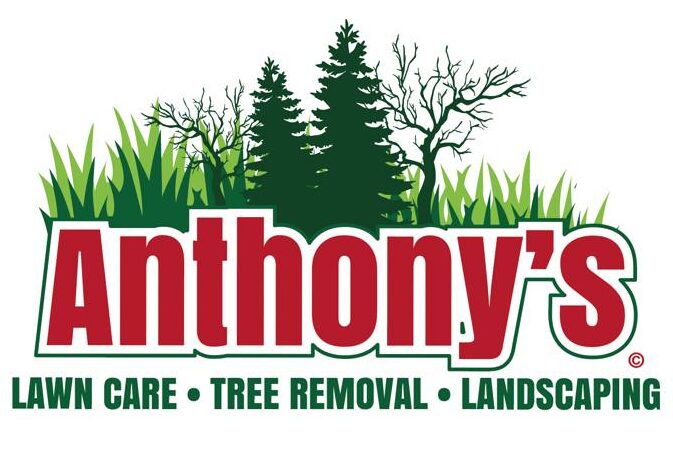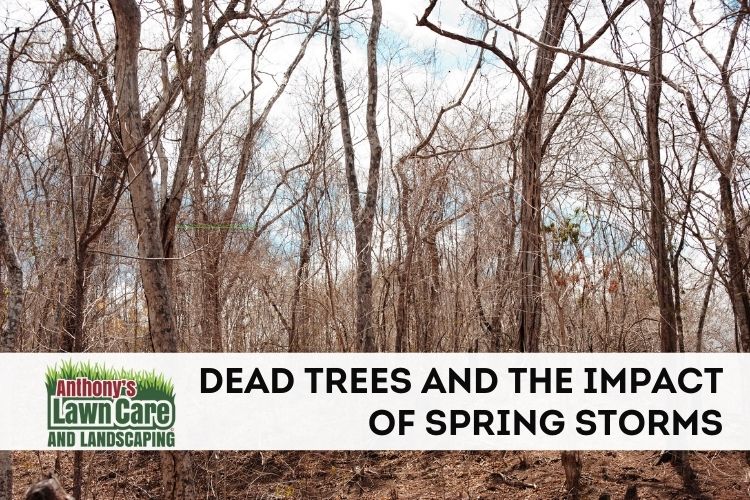If you’ve ever wondered if that tree in your backyard is dead, don’t let a storm this spring give you the answer, along with costly damage, injuries or even death. Dead trees pose a particular risk when the winds whip up, so here are a few things that every homeowner should look out for when preparing for spring storms in Indiana. Keep in mind that most dead trees are extremely dangerous to remove without professional assistance and properly identifying a dead tree is only step one to prepare for a safe yard during a spring storm.
Investigate potential dead or dying trees
Starting from the bottom going up:
- Do you see sitting water or soggy soil? This can weaken roots and cause permanent damage to a tree. Root systems that have too much water at the surface tend to not have healthy deep roots which can compromise the strength of the tree itself. This can lead to tree death.
- Are there fungi at the roots? Some fungi may be attractive, but are often a sign that the inside of a tree is dead or dying.
- Is the bark missing or cracking? As the tree’s skin, the bark is there to protect the inner trunk. A tree is likely dying or dead if the bark has vertical cracks, falling off on its own, or has no bark at all.
- Is the tree leaning severely to one side or the other? If the tree has started leaning to one side, quite simply, the roots on the other side are damaged and unable to take in nutrients or hold that side of the tree to the ground. This is a strong indication of tree death, disease, or decay.
- Are the branches brittle? Sometimes a branch can look browned or dead but in reality the inner layer, called the cambium, is healthy. The best way to know is to perform a scratch test. Choose a few small branches and twigs that appear dead, and a spot about halfway up the trunk. Starting with the spot on the trunk, with a small pocket knife, scratch just enough of the top layer of the bark off to reveal the cambium layer. If this second layer is green, then it is “wick.” “Wick” is an old British term, meaning “alive,” that is often used by arborists to indicate a healthy tree. Perform the scratch test on the chosen branches and even attempt to snap a few of the small twigs to see if they resist. Any green color is good, but because some branches may be dead and others may not be, it is not a perfect test. It will just give you a better idea of whether your tree is wick or not.
- How thick is the foliage? Any lack of nutrients can affect the growth of leaves, so a thinning canopy can be an immediate indication of disease or decay. If spring is approaching and the tree is still sparse or has mostly brown leaves, perform the scratch test on the branches that lead to those leaves to see if there is any green under the bark.
The dangers from a falling dead tree in a storm cannot be understated. Even just attempting to remove it yourself will involve the same risks. And while a storm felling a tree is sometimes covered under your property insurance, any damage or injury that happens if you are trying to remove a dangerous tree without the licensed professionals, is typically not. Keep in mind what is at risk.
Property Damage
In a storm, a tree could fall quickly and cause extensive destruction. A professional removing a tree would cost 10 times less than the cost of repairing a roof or garage or replacing a vehicle. And depending on how close the tree is to the neighbors, you may not only be putting your own property at risk and would therefore be responsible for whatever damage you cause to their home or vehicles.
Power Lines
Branches hitting power lines and cutting off necessary electricity or other utilities is a major risk during storms and a major reason to call an experienced arborist. Aside from the obvious dangers of a live wire in the streets or lawns, many people depend on electricity for medical equipment, or even to just keep things like insulin refrigerated, which would mean that the whole neighborhood is affected.
Injuries or death
Perhaps the most worrying dangers are to those that we love. Whether the tree is falling on your house, your neighbor’s car, or over a sidewalk, after a storm there are always heartbreaking stories of injury or death due to dead or dying trees falling. This happens also when a novice attempts to remove a problem tree without professional assistance.
If you have identified a potential dead or dying tree in your yard, it is important that you contact a professional to get an opinion on whether it should be taken down. Anthony’s Lawn Care and Landscaping in Bloomington has years of experience with licensed and bonded professionals who can provide a free estimate for tree removal before the spring storms come. For the safety of your property, power lines, family, visitors, neighbors, and pets, contact them at 812.345.5694.


Recent Comments